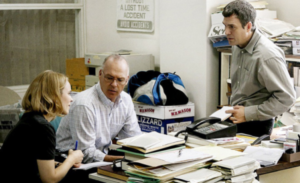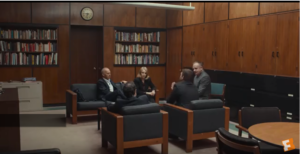‘Spotlight’ is the 2015 film directed by Tom McCarthy about the Boston Globe newspaper’s investigative team and how they researched and published a series of articles that exposed the systematic involvement of the Catholic Church in protecting priests who molested children.
This film went on to win the Academy Award for Best Picture in 2016. When I first watched the film, I had an expectation that this would be a dramatic and heart-wrenching movie. Instead, I found it to be an understated (given the seriousness of the story) and cinematically ‘flat’ movie. At first I was disappointed and surprised that it had won the Oscar.
Having looked at a number of online reviews of the movie, I could find a number of criticisms that related mainly to the lack of a personal development arc for any of the main characters. Tom McCarthy has defended this approach by saying that the story was more important than the characters. He went on further to say that very early on in the development of the film they made a decision to concentrate on the ensemble of journalists involved in the Spotlight investigation rather than just one or two characters. One of the consequences of this choice was that there was also limited time to concentrate on each individual and their personal journey whilst involved in this investigation. The most they achieved were a few snippets of information; Sacha Mc Pfeiffer routinely going to church with her grandmother and then stopping as she becomes more disillusioned with the church, Matt Carol realising that there are priests capable of molesting children living close to his house and Mike Rezendes having a meltdown when he realises how extensive the problem was in Boston.
It appears that the director elected to intentionally downplay the personal dramas of the journalists, priests and victims so as to give voice to the larger story of institutionalised and global covering up of priests who abused children.
Cinematically, three features stand out. The first is that the predominant colours were white, dull blue and grey. I believe that these colours signify at times the false mundanity of the story, at times it shows that investigative journalism is predominantly just hard slog without any flashy revelations and drama. The second is that many of the shots lack depth. Along with the dull colours there is very little contrast in the shots which are usually filmed inside offices, living rooms and other fairly closed spaces.
It seems that the journalists wear predominantly white or pastel coloured clothing while they are together in the offices or with collaborators. When they are with people who are either not cooperating or outright hostile, the colours become much darker. The first picture is a typical office scene where the journalists are discussing a part of the investigation, whereas the second picture is when Robby and Sacha meet with the governors of one of the schools where the abuse took place and these people are trying to deny any knowledge of what took place.


I do wonder if this lack of visual ‘glitz’ is intentional and obliges the viewer to yet again focus on, and ultimately, remember the main message in the film.
The third cinematic feature and the one that caused me more difficulties, is that the vast majority of the shots are close-up or over-the-shoulder shots. I would go so far as to say that the film is told almost exclusively through dialogue scenes with the transitions being when an actor moves from one conversation to the next one. Alfred Hitchcock once said that you should save close-ups for when you need dramatic effect and that over-use of close ups could reduce that impact. I wondered if this story would be more effective as a book. This is reliance on dialogue and close-up is apparent even in the trailer for the movie which is linked below.
